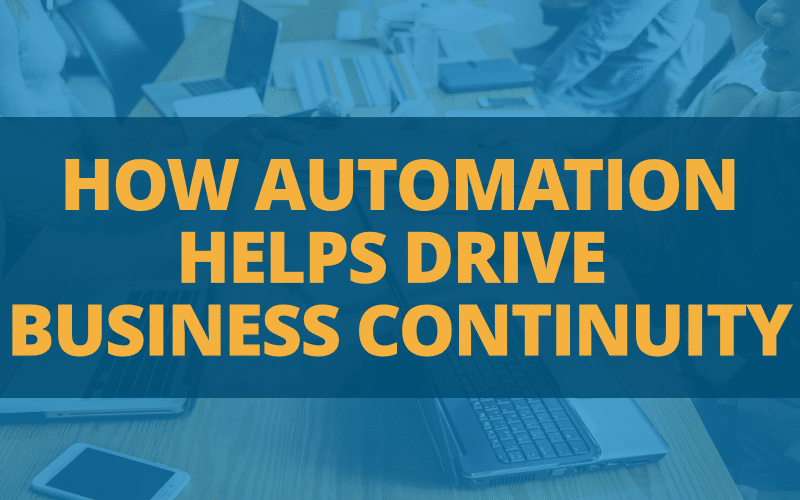Business continuity is an organization’s ability to ensure operations and core business functions are not severely impacted by a disaster or unplanned incident.
It has become even more apparent how critical organizational resiliency is during a crisis like the one we are currently experiencing. Business continuity reminds me of a left tackle in football: if you never hear his name, things are going well. But if his number is called, something has gone wrong. Such is the concept of creating organizational resiliency with good business continuity practices. You don’t realize you have a problem until it is too late.
Building an organization with a focus on business continuity is an often-overlooked role of C-level executives yet is one of the most critical aspects of the job. In considering IT, how do you create an environment that is resilient in times of crisis or when that key individual moves on? It’s commonplace to find IT organizations—especially small to mid-sized companies—with only one person responsible for performing a key, yet mundane task. They have their own process and spreadsheets that they use to manage that task. That individual becomes critical when they are the only person familiar with that task and their process. It is the function of an IT leader to identify these single points of failure and create a business process designed to perform that task whether that IT staffer shows up or not.
The thought of utilizing technology and automation to replace a function that a person performs can be scary to IT managers — and especially to the person performing the function. I have often been given the Heisman (the one-armed push back for you non-football fans) by individuals who feel threatened by the automation and processes being presented as an overall business continuity strategy. What many of those fearful individuals don’t want to realize — what they are actively choosing not to acknowledge — is that the tech industry is moving towards more automation, not less. That Titanic of a business trend is not going to slow down and promises to sink them if they don’t begin to see these realities as opportunities rather than threats. The astute IT professional doesn’t look for ways to hide under the archaic spreadsheets they manage; they look to improve the business by identifying ways to eliminate those spreadsheets. The only thing an IT professional should be afraid of is allowing the tsunami of change to swallow them up. They should be surfing the wave!
Where do opportunities for improving organizational resiliency exist? Data has become a valuable asset for most businesses. For IT professionals, it has become critical that they enable their organization to utilize this asset to make more informed business decisions. An initial step is to find areas where data is either being collected (i.e. in spreadsheets or other autonomous forms) or isn’t being collected at all. I encounter this often within an organization’s mobile environment. Using spreadsheets to attempt to track mobile assets is, at best, time consuming and at worst, a futile endeavor. Implementing a system that automatically captures inventory information at the time a change is made is essential to accurately understanding and controlling assets and having visibility into carrier errors and costs. Don’t allow the fox to watch the hen house…that approach has been costing organizations piles of money for decades. Not only will implementing a system save money, it will improve business continuity as you are no longer relying on an individual but a process.
Within technology environments, one sought-after solution is the ability to reconcile inventory with billing. Vendors that provide technology services have never been experts in billing. Gartner estimated that 80% of telecom carrier bills contain errors. The ability to ensure billing accuracy by introducing automation to efficiently report on any discrepancies will reduce costs. It is nearly impossible to accomplish this with manual processes and spreadsheets. And, again, you have created more organizational resiliency by introducing a process to replace someone’s spreadsheet.
Automation reigns supreme in the optimization process and, subsequently, in business continuity. Whether you are optimizing your mobile rate plans, cloud spend, or SaaS licenses, automation offers the only efficient way to maintain low costs across technology environments and ensure operational resiliency. Companies have been overpaying for mobile services for years due to the lack of optimization. And as cloud services grow at an exponential rate, the savings opportunities offered by optimizing cloud spend could dwarf savings obtained in the mobile environment. The challenge faced by IT professionals to ensure costs are as low as possible isn’t going away. Technology providers can all too easily take advantage of a customers’ lack of automation and information. It’s essential that IT organizations arm themselves with the knowledge and solutions necessary to mitigate this waste.
Introducing automation drives waste out of IT environments and is a great way to ensure these essential practices continue whether the “mobile guy” comes to work or not.
The right software and/or managed services can help create a resilient IT organization, one that relies on processes, procedures, and automation rather than one that relies on a single individual.


